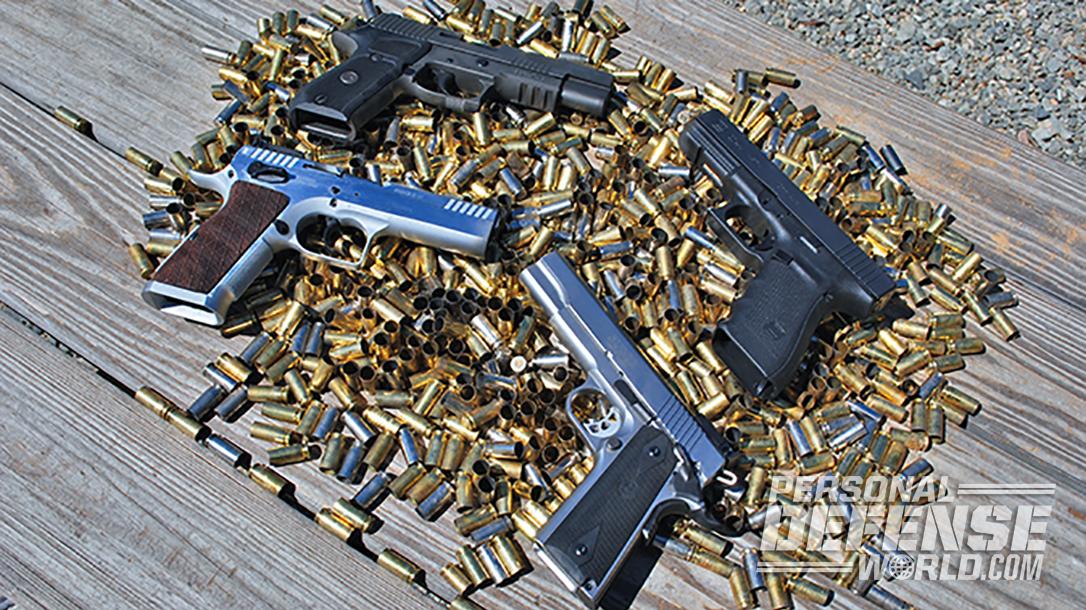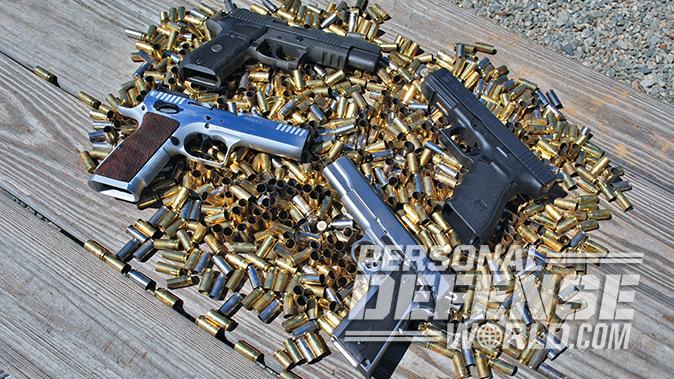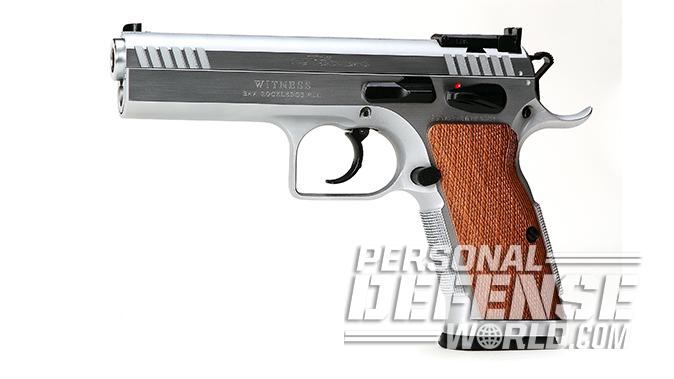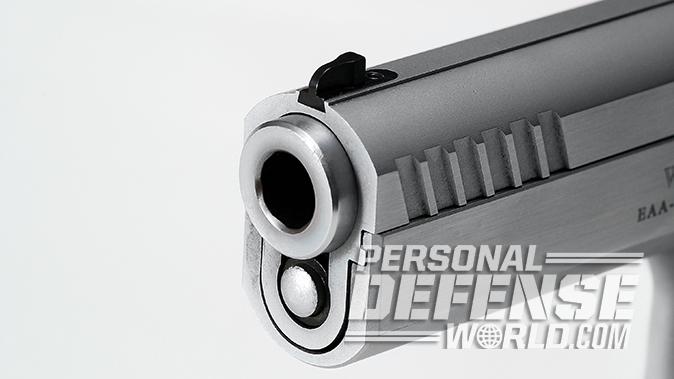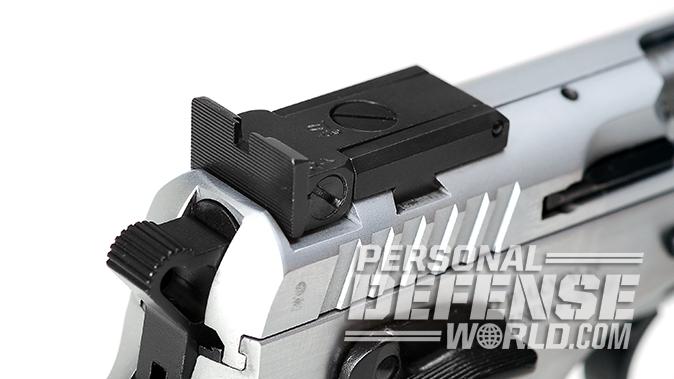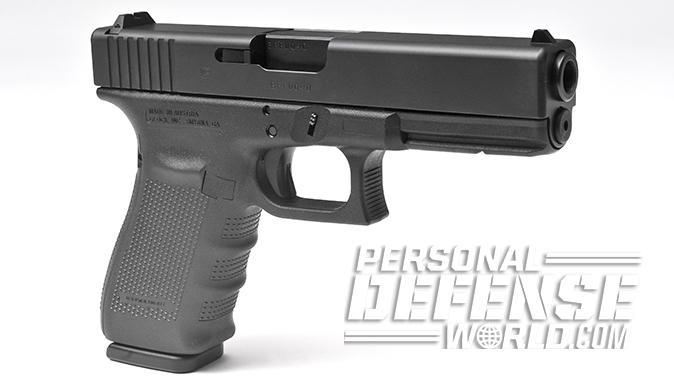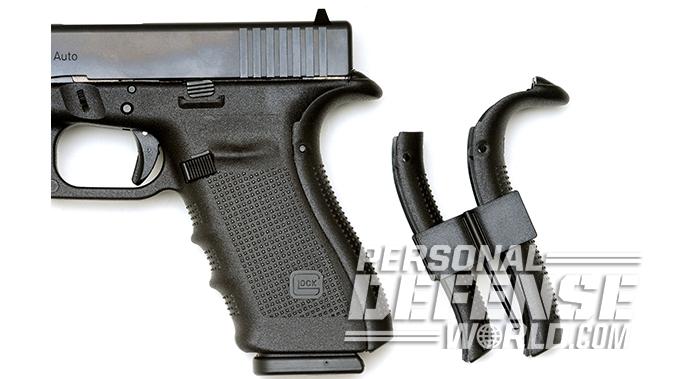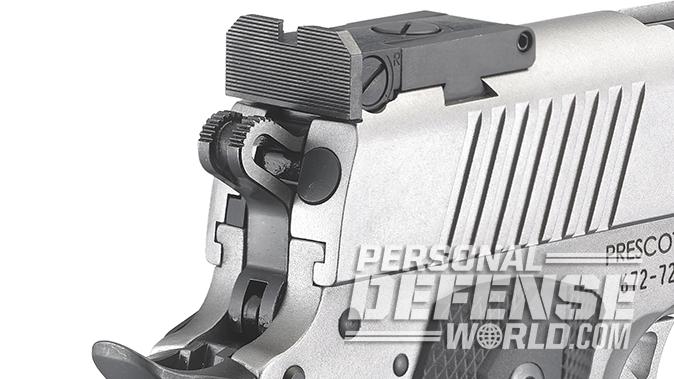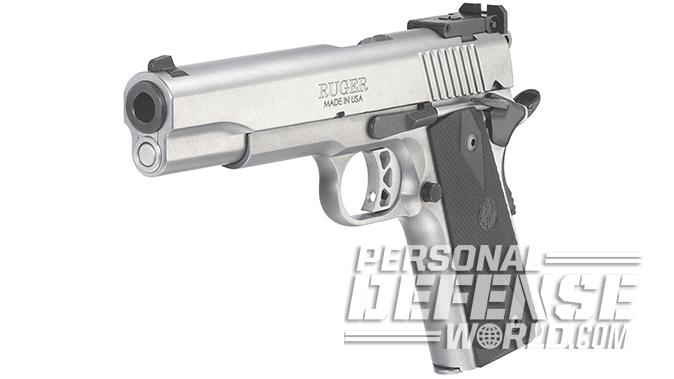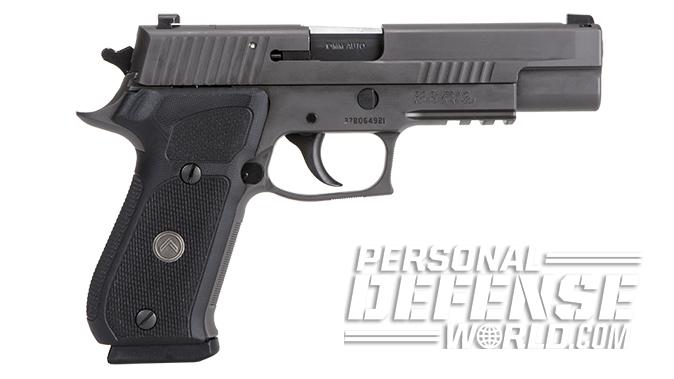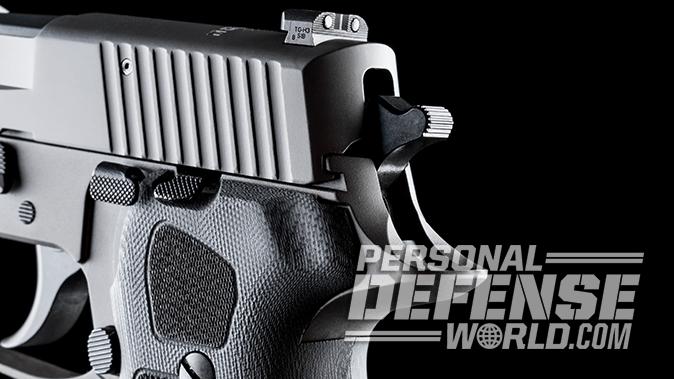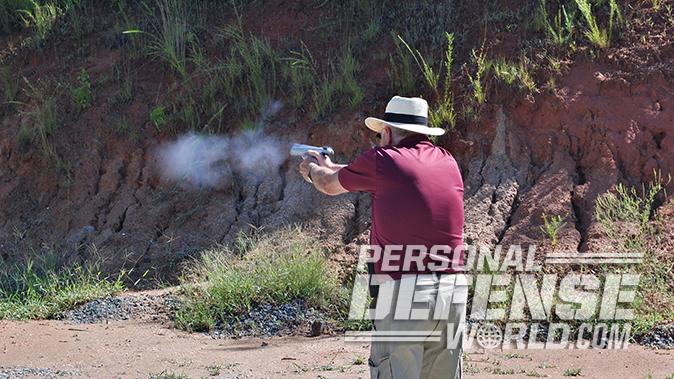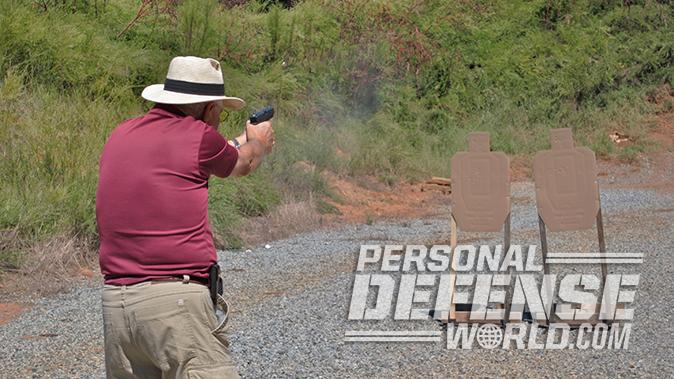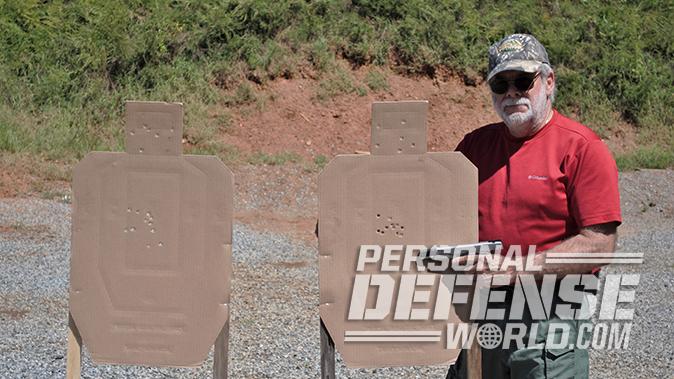While the new breed of high-performance 9mm ammunition, and the pistols chambered for it, seem to be getting all the ink in today’s gun press, there has been a resurgence of interest in another pistol cartridge that has gone virtually unnoticed for years: the 10mm Auto.
The 10mm’s story begins in the late 1970s, when American police forces were switching from .38 Special/.357 Magnum revolvers to 9mm pistols. This change was accompanied by much debate as the fans of the 9mm pointed out the cartridge’s longer range, flatter trajectory and higher magazine capacity. On the other side was the “bigger bullets” crowd that believed it was foolish to go into harm’s way with a handgun whose caliber did not approach half an inch.
Enter a man named Whit Collins, who proposed a medium-caliber cartridge that propelled a bullet of approximately 200 grains traveling at 1,000 fps to provide the ballistic advantages of the 9mm and the fight-stopping ability of the .45 ACP, along with higher magazine capacity. None other than Colonel Jeff Cooper lent his support to the idea, and with the assistance of Irv Stone of Bar-Sto and gunsmith John French, they modified a Hi-Power pistol to fire the wildcat .40 G&A, which propelled a 180-grain bullet to 1,050 fps from a 5-inch barrel.
Advertisement — Continue Reading Below
Cooper then teamed up with Thomas Dornaus and Michael Dixon to develop a longer cartridge more suitable to existing .45 ACP platforms. Dornaus and Dixon formed a company to manufacture a pistol based upon the CZ 75. The resulting pistol, dubbed the Bren Ten, was built for the new 10mm Auto cartridge. They arranged for Norma to further develop the cartridge, but the end product was considerably hotter than had originally been envisioned, propelling a 170-grain JHP to 1,300 fps and a 200-grain FMJ to 1,200 fps.
Unfortunately, manufacturing problems led to the demise of the Bren Ten, but over the years a number of companies have produced 10mm pistols. It was adopted for a short time by the FBI, but they found the pistol’s weight and recoil problematic. Some U.S. police departments use 10mm pistol models, and the government of Denmark issues them to personnel of the Sirius Sledge Patrol in northeast Greenland for defense against polar bears.
The Contenders
Certain commercial 10mm Auto loads produce levels of energy that approach those of the .41 Magnum revolver cartridge. This is the reason for the resurgence of interest in the 10mm, primarily among handgun hunters who prefer to use a semi-automatic model rather than a revolver.
Advertisement — Continue Reading Below
Last time we did something like this, we ran four .45 ACP pistols against each other, so this time around we chose four popular 10mm pistol models for comparison: the Ruger SR1911 Target, Glock 20 Gen4, EAA Witness Elite Stock II and Sig Sauer P220 Legion. While all are chambered for the 10mm Auto cartridge, they each differ in significant areas.
Ruger’s 10mm SR1911 Target is an all-stainless-steel 1911 and is notable as the first SR1911 to use a fully supported, ramped, bushing-less, match-grade bull barrel for enhanced accuracy and additional recoil-dampening weight. It has a single-action trigger, a single-stack magazine and an adjustable rear sight.
Advertisement — Continue Reading Below
I have long said that “a Glock is a Glock is a Glock,” and the Glock 20 Gen4 proves it. It has the breed’s polymer frame, internal components and Safe Action trigger, and it’s the only one of our four test pistols that is striker-fired. It also uses interchangeable backstraps so shooters can modify the grip to fit their hands, and it has the highest capacity of our test guns. It is also the most affordable of the quartet.
Made in Italy by Tanfoglio, the EAA Witness Elite Stock II is an all-stainless-steel pistol with a double- action/single-action (DA/SA) trigger system and an ambidextrous safety on the frame. The full-length slide rails are on the inside of the frame, which lets the slide sit deeper, lowering the bore axis to reduce felt recoil and muzzle flip. It also has a fully adjustable rear sight, and the magazine holds 14 rounds of ammo.
Like the EAA pistol, Sig Sauer’s P220 Legion uses a DA/SA trigger and has a stainless steel frame and slide. But like the Ruger, it has an eight-round, single- stack magazine. It is hammer-fired with a decocking lever located in front of the left grip panel, and it is the only one of the quartet that comes standard with night sights. It’s also the heaviest of the four test guns.
Advertisement — Continue Reading Below
Match Rules
Obtaining the able assistance of my shooting buddies, Dick Jones and Richard Cole, we decided to run our four 10mms through the following series of drills.
• Paper/Popper Drill: Lift the pistol and engage two cardboard targets on the left or right at 8 yards with one round each, then shoot the steel popper down before engaging the pair of targets on the right side with one round each. The popper must go down before engaging the remaining targets. Perform a combat reload and repeat the drill. Run the drill two more times for a total of 30 rounds.
• FBI Drill: Lift the pistol and fire two body shots and one headshot on a pair of targets at 7 yards. Reload and repeat. Run the drill two more times for a total of 36 rounds.
Advertisement — Continue Reading Below
• Speed Drill: Lift the pistol and engage three cardboard targets at 7 yards. Fire eight rounds on the first target, perform a combat reload and engage the second target, perform a combat reload and engage the third target for a total of 24 rounds.
With those pistols having DA/SA triggers, the first shot in each string was fired in DA mode. Makeup shots would be allowed for misses only. This meant that each shooter would fire a minimum of 90 rounds through each pistol for a total of at least 360 rounds from all four.
For the sake of consistency, we decided to use a specific brand of ammo with each pistol: Sig Sauer 180-grain FMJs for the P220; Hornady 180-grain XTPs for the Ruger; Remington 180-grain FMJs for the Glock; and Federal 180-grain JHPs for the EAA. Once again, Anthony Welsch at the Target Bar provided a quantity of IPSC cardboard targets while Birchwood Casey sent us one of its new self-setting steel popper targets.
Advertisement — Continue Reading Below
The Battle Begins
Each shooter would grade each pistol on a one (worse) to five (best) scale in seven categories: reliability, ergonomics, trigger control, sights, recoil control, off-hand accuracy and ease of reloading. These were then added together to give each pistol a final score in each category.
As is our SOP in these shootouts, I zeroed each pistol with its specific brand of ammo from an MTM K-Zone rest at 50 feet. I was pleased to see that all four were capable of groups in the 2-inch range. I then field-stripped, cleaned and lubricated each pistol, which would be the only maintenance they would receive. If one malfunctioned, we would attempt to correct the problem and continue shooting.
We met at the Piedmont Handgunners Association range. After unpacking all of our gear and setting up the targets, we began to send 10mm Auto projectiles downrange. Taking turns, one of us would shoot, another would serve as a range officer and the third would load magazines. We began shooting at 10:45 a.m., and except for a short break for lunch, we shot until 3:00 p.m. When we were finished, we figured we had expended in excess of 1,100 rounds of 10mm ammunition to come to the following results, with 15 being a perfect score:
Advertisement — Continue Reading Below
| Manufacturer | Reliability | Ergonomics | Trigger Control | Recoil Control | Sights | Off-Hand Accuracy | Reloading Ease | Total |
|---|---|---|---|---|---|---|---|---|
| EAA Witness Elite Stock II | 15 | 14 | 12 | 14 | 11 | 14 | 13 | 93 |
| Glock 20 Gen4 | 15 | 9 | 10 | 10 | 9 | 12 | 15 | 80 |
| Ruger SR1911 Target | 14 | 14 | 15 | 13 | 10 | 15 | 14 | 95 |
| Sig Sauer P220 Legion | 15 | 12 | 12 | 14 | 14 | 12 | 6 | 85 |
Since a few of these scores might be surprising to some of our readers, explanations are in order. In terms of reliability, we had a total of three failures to chamber with the Ruger SR1911 Target while the other four pistols ran flawlessly.
While ergonomics is a subjective call, all of us found the Glock’s frontstrap checkering chafed the middle fingers of our shooting hands after extensive firing. Its grip-to-frame angle caused it to point high for two of us, forcing us to pull the muzzle down to get a proper sight picture. The Ruger is a 1911—enough said. The EAA’s grip frame was very comfortable and provided a natural- pointing pistol. Two of us found the Sig to be muzzle heavy. The controls on all four pistols operated as expected, although one of us found the EAA’s safety too high to operate with the strong-hand thumb. There was another issue with the Glock’s flat slide release being difficult to manipulate for one of our testers.
Advertisement — Continue Reading Below
The Ruger’s short SA trigger was the unanimous choice among the four guns. Two shooters found the EAA and Sig’s curved triggers pinched their trigger fingers unless they placed them high on the trigger. Of our two DA/SA pistols, the EAA had the lightest, smoothest DA stroke, but one shooter felt it required excessive travel to reset. The Glock’s Safe Action trigger was like every other Glock trigger we’ve ever fired with a short stroke. It was easy to use but quite gritty.
It came as no surprise that the Glock, being the lightest of the four pistols, had the heaviest recoil. The two that weighed the most, the Sig and EAA, were the most controllable, especially in rapid fire, with the Ruger coming in close on their heels.
What about the sights? The Sig’s bright green fiber-optic front sight got a thumbs up from the three of us. Both the Ruger and EAA had plain black front sights, but the former’s had an angled rear edge that tended to disappear if the sun hit it at the right angle. We all found the Glock’s sights a bit too large for fine shooting and did not care for the white outline on the rear sight. Aside from the Sig, the rest of the pistols would benefit from fiber-optic front sights.
Off-hand accuracy is another subjective call. It can be said that all four pistols showed themselves to be accurate enough for defensive/police-type service. That being said, the three of us agreed that the Ruger and EAA pistols would be the most suitable for hunting—that is, once you installed the aforementioned fiber-optic front sights.
Thanks to its large magazine release and wide magazine well, the Glock finished first in the reloading category. The Ruger would greatly benefit from a magazine well funnel. While the EAA had a large-mouthed magazine well opening, on several occasions its magazines did not fall free when the release was pressed. We all had trouble accessing the Sig’s magazine release; this pistol would benefit greatly if it was fitted with an extended release.
I would like to mention that, despite the 10mm Auto producing near .41 Magnum ballistics, we found that the recoil, while sharp, was not as uncomfortable as we had expected. In fact, I believe that firing this much ammunition from a magnum revolver would have been much more painful for all of us.
Tally Of The Tens
As you can see, each of these guns has its strengths and weaknesses. Only you can decide which will fit your needs best. Overall, I feel that the 10mm Auto cartridge is a viable choice for personal protection or law enforcement service as long as the shooter obtains the necessary amount of instruction and enough practice so as to become proficient with heavier-recoiling pistols.
I also believe that the 10mm pistol would be more than suitable for hunting medium-sized game such as whitetail deer, feral hogs, goats and large vermin, or as a survival handgun for campers, boaters or pilots. I expect the 10mm’s popularity to continue to grow as more shooters become acquainted with the capabilities of this “magnum” pistol caliber.
10mm Pistol Specs
| Manufacturer | EAA Witness Elite Stock II | Glock 20 Gen4 | Ruger SR1911 Target | Sig Sauer P220 Legion |
|---|---|---|---|---|
| Caliber | 10mm Auto | 10mm Auto | 10mm Auto | 10mm Auto |
| Barrel | 4.5 inches | 4.6 inches | 5 inches | 5 inches |
| OA Length | 8 inches | 8.03 inches | 8.67 inches | 8.3 inches |
| Weight | 43 ounces (empty) | 30.7 ounces (empty) | 40.4 ounces (empty) | 44.6 ounces (empty) |
| Grip | Walnut | Polymer | Rubber | G10 |
| Sights | Blade front, adjustable rear | Blade and notch | Blade front, adjustable rear | X-Ray day/night |
| Action | DA/SA | Semi-automatic | SA | DA/SA |
| Finish | Stainless | Matte black | Stainless | Legion gray |
| Capacity | 14+1 | 15+1 | 8+1 | 8+1 |
| MSRP | $1,126 | $687 | $1,019 | $1,943 |
For More Information
Glock
us.glock.com
Ruger
ruger.com
Sig Sauer
sigsauer.com
This article is from the January/February 2018 issue of “Combat Handguns” magazine. To order a copy and subscribe, visit outdoorgroupstore.com.
